The Local Ordered Charging Strategy of Electric Vehicles Based on Energy Routers under Three-Phase Balance of Residential Fields
Abstract
:1. Introduction
2. Characteristic of Power Load in Typical Residential Area
2.1. Analysis of Power Consumption Characteristics of Typical Equipment of Residential Users
2.1.1. Characteristics of Household Load Power Consumption
2.1.2. Residents Electric Vehicle Travel and Charging Rules
3. Local Orderly Charging Strategy for Electric Vehicles Based on Energy Router under Three-Phase Balance in Residential Areas
3.1. The Optimization Goal
- Charging time constraint
- 2.
- Transformer capacity constraint
- 3.
- Photovoltaic output power constraints
- 4.
- Energy storage operation constraint
- 5.
- Constraints on charging capacity of electric vehicles
3.2. Solution Strategy
4. Simulation Analysis
5. Conclusions
Author Contributions
Funding
Institutional Review Board Statement
Informed Consent Statement
Data Availability Statement
Acknowledgments
Conflicts of Interest
References
- Ding, M.; Wang, W.; Wang, X.L. A review on the effect of large—Scale PV generation on power system. J. Proc. CSEE 2014, 34, 1–14. [Google Scholar]
- Alkawsi, G.; Baashar, Y.; Abbas, U.D.; Alkahtani, A.A.; Tiong, S.K. Review of Renewable Energy-Based Charging Infrastructure for Electric Vehicles. J. Appl. Sci. 2021, 11, 3847. [Google Scholar] [CrossRef]
- Zhu, X.J.; Chen, X.; Li, Y. Optimal dispatching of active distribution network considering electric vehicle access. J. Electr. Power Eng. Technol. 2021, 40, 141–147. [Google Scholar]
- Hu, Z.C.; Song, Y.H.; Xu, Z.W. The impact and role of electric vehicle access to the grid. J. Proc. CSEE 2012, 32, 1–10. [Google Scholar]
- Su, H.F.; Zhao, K.W.; Li, Y.; Li, M.; Wen, H.L.; Wang, Y. Large-scale electric vehicle three-phase load balancing charging line selection device and simulation analysis. J. Electr. Power Autom. Equip. 2018, 38, 103–108. [Google Scholar]
- Wang, R.C. Influence of Distribution Network Three-phase Unbalance on Line Loss Increase Rate and Voltage Offset. J. Electr. Power Eng. Technol. 2017, 36, 131–136. [Google Scholar]
- Zhang, Y.P.; Guo, C. Review on the Influence of Distributed Photovoltaic Grid Connection on Distribution Network. J. Yunnan Electr. Power 2021, 49, 38–43. [Google Scholar]
- Yang, Y.L.; Wang, F.Q. Additional Loss and Voltage Deviation Caused by Unbalanced Operation of Distribution Transformer and Countermeasures. J. Power Syst. Technol. 2004, 8, 73–76. [Google Scholar]
- Yang, X.R.; Lu, L.; Xiang, Y. Bad charging scenario of electric vehicles under “vehicle-road-grid” coupling and its impact on voltage stability of urban distribution network. J. Electr. Power Autom. Equip. 2019, 39, 102–108. [Google Scholar]
- Sun, G.Q.; Xug, K.; Shen, P.F. Coordinated Economic Dispatch of Flexible District for Large-scale Electric Vehicle Load. J. Power Syst. Technol. 2020, 44, 4395–4404. [Google Scholar]
- Han, H.C.; Ding, H.; Huang, D. Electric Vehicle Power Control Strategy for Active Distribution Network. J. Electr. Power Eng. Technol. 2017, 36, 8–13. [Google Scholar]
- Wang, W.; He, X.; Wang, Q. Impacts of Electric Vehicles Charging on Grid Load and Electrical Equipment. J. Distrib. Util. 2018, 35, 79–84. [Google Scholar]
- Wang, H.; Yu, Z.S.; Li, X.J.; Bian, J. Comprehensive Risk Assessment of Multi-type Electric Vehicles Connected to Distribution Network Based on Principal Component Analysis Method. J. Electr. Power Autom. Equip. 2021, 41, 57–65. [Google Scholar]
- Wang, S.N.; Yang, S.B. A Coordinated Charging Control Strategy for Electric Vehicles Charging Load in Residential Area. J. Autom. Electr. Power Syst. 2016, 40, 71–77. [Google Scholar]
- Xu, H.; Xia, X.J.; Li, H. An Ordered Charging Strategy for Electric Vehicles Accounting the Compensation of Predicted Charging Requests. J. Power Syst. Prot. Control. 2016, 44, 74–81. [Google Scholar]
- Dong, T.; Yong, J.; Zhao, J. Load Management Approach for Residential Power System Incorporating Photovoltaics, Electric Storage and Electric Vehicle Charging. J. Chongqing Univ. 2021, 44, 45–58. [Google Scholar]
- Singh, M.; Kar, I.; Kumar, P. Influence of EV on grid power quality and optimizing the charging schedule to mitigate voltage imbalance and reduce power loss. In Proceedings of the Power Electronics & Motion Control Conference, Ohrid, North Macedonia, 6–8 September 2010. [Google Scholar]
- Fu, Y.; Meng, X.H.; Su, X.J. Coordinated Charging Control of PEV Considering Inverter’s Reactive Power Support and Three Phase Switching in Unbalanced Active Distribution Networks. J. Electr. Power Autom. Equip. 2020, 40, 1–12. [Google Scholar]
- Boonseng, T.; Sangswang, A.; Naetiladdanon, S.; Gurung, S. A New Two-Stage Approach to Coordinate Electrical Vehicles for Satisfaction of Grid and Customer Requirements. J. Appl. Sci. 2021, 11, 3904. [Google Scholar] [CrossRef]
- Krim, Y.; Sechilariu, M.; Locment, F. PV Benefits Assessment for PV-Powered Charging Stations for Electric Vehicles. J. Appl. Sci. 2021, 11, 4127. [Google Scholar] [CrossRef]
- Smith, T.; Garcia, J.; Washington, G. Smart Electric Vehicle Charging via Adjustable Real-Time Charging Rates. J. Appl. Sci. 2021, 11, 10962. [Google Scholar] [CrossRef]
- Samuel, P.; Eddaaif, R.; González-Zumba, A.; Clairand, J.-M. Assessment of the Impact of Electric Vehicle Batteries in the Non-Linear Control of DC Microgrids. J. Appl. Sci. 2021, 11, 4415. [Google Scholar] [CrossRef]
- Wang, Z.P. Research on Orderly Charging of Electric Vehicles and Vehicle Network Interaction Technology under Dual-Carbon Targets. J. Electr. Power Eng. Technol. 2021, 40, 1. [Google Scholar]
- Li, Q.S.; Xiao, X.N.; Guo, J. Research on Scheme for Ordered Charging of Electric Vehicles. J. Power Syst. Technol. 2012, 36, 32–38. [Google Scholar]
- Tang, J.M.; Wang, J.; Liu, S.M. Research on Dispatching Strategy of Microgrid with Electric Vehicle. J. Electr. Power Sci. Eng. 2021, 37, 25–31. [Google Scholar]
- Tang, W.; Li, T.R.; Zhang, L.; Cai, Y.X.; Zhang, B.; Wang, Z.Q. Photovoltaic-energy storage coordinated control of low-voltage distribution network based on three-phase four-wire optimal power flow. J. Autom. Electr. Power Syst. 2020, 44, 31–40. [Google Scholar]
- Ma, Y.Z.; Ma, Z.X. Orderly charging optimization and benefit analysis of electric vehicles based on game algorithm. J. Electr. Power Eng. Technol. 2021, 40, 10–16. [Google Scholar]
- Shen, G.H.; Chen, G.; Zhao, Y.; Li, X.G.; Geng, A.G.; Yuan, H.; Liu, F. Orderly charging strategy for electric vehicles based on bi-objective hierarchical optimization and TOPSIS ranking. J. Power Syst. Prot. Control 2021, 49, 115–123. [Google Scholar]
- Cai, Z.L.; Shu, H.C.; Yang, B.; Shan, J.S. An orderly charging strategy for electric buses taking into account the preparation of travel plans. J. Electr. Power Autom. Equip. 2021, 41, 45–56. [Google Scholar]
- Wang, X.F.; Su, H.L.; Song, T.L. Differential Customer Baseline Load Forecasting Based on Load Subdivision. J. Electr. Power Eng. Technol. 2018, 37, 33–38. [Google Scholar]
- Meng, M.; Chen, S.C.; Zhao, S.J. Contrastive Analysis on Residential Load and Commercial Load of Urban Distribution Network. J. Proc. CSU-EPSA 2018, 30, 97–103. [Google Scholar]
- Sun, C.; Li, T. Classification of electric vehicle charging time series with selective clustering. J. Electr. Power Syst. Res. 2020, 39, 180–189. [Google Scholar] [CrossRef]
- Zhang, L.; Yan, Z.; Feng, D.H. Two-Stage Optimization Model Based Coordinated Charging for EV Charging Station. J. Power Syst. Technol. 2014, 38, 967–973. [Google Scholar]
- Wang, G.S.; Xiao, B.T.; Lai, X.L.; Zhang, T.N.; Liu, Y.; Yi, J.B. Smooth control strategy of energy storage system taking into account wind power fluctuation and battery state of charge. J. Acta Energ. Sol. Sin. 2021, 42, 280–286. [Google Scholar]
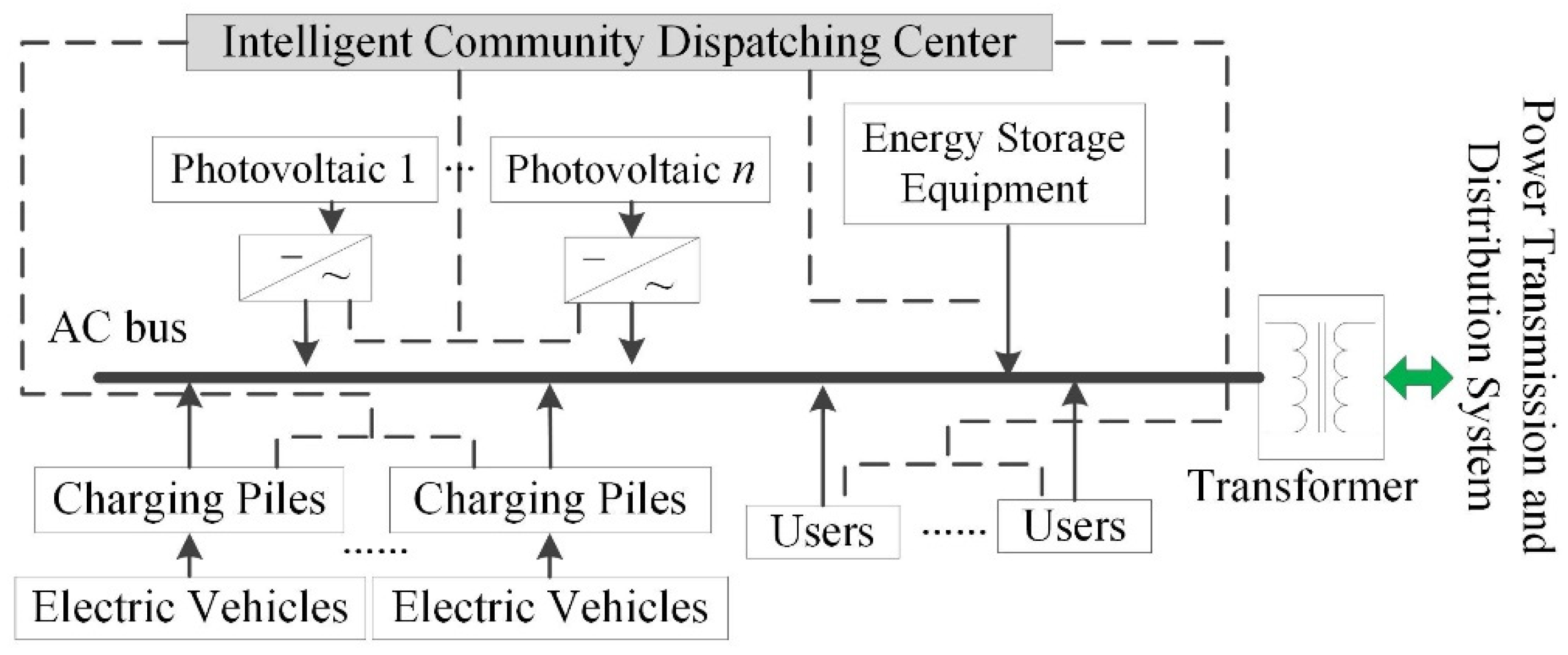


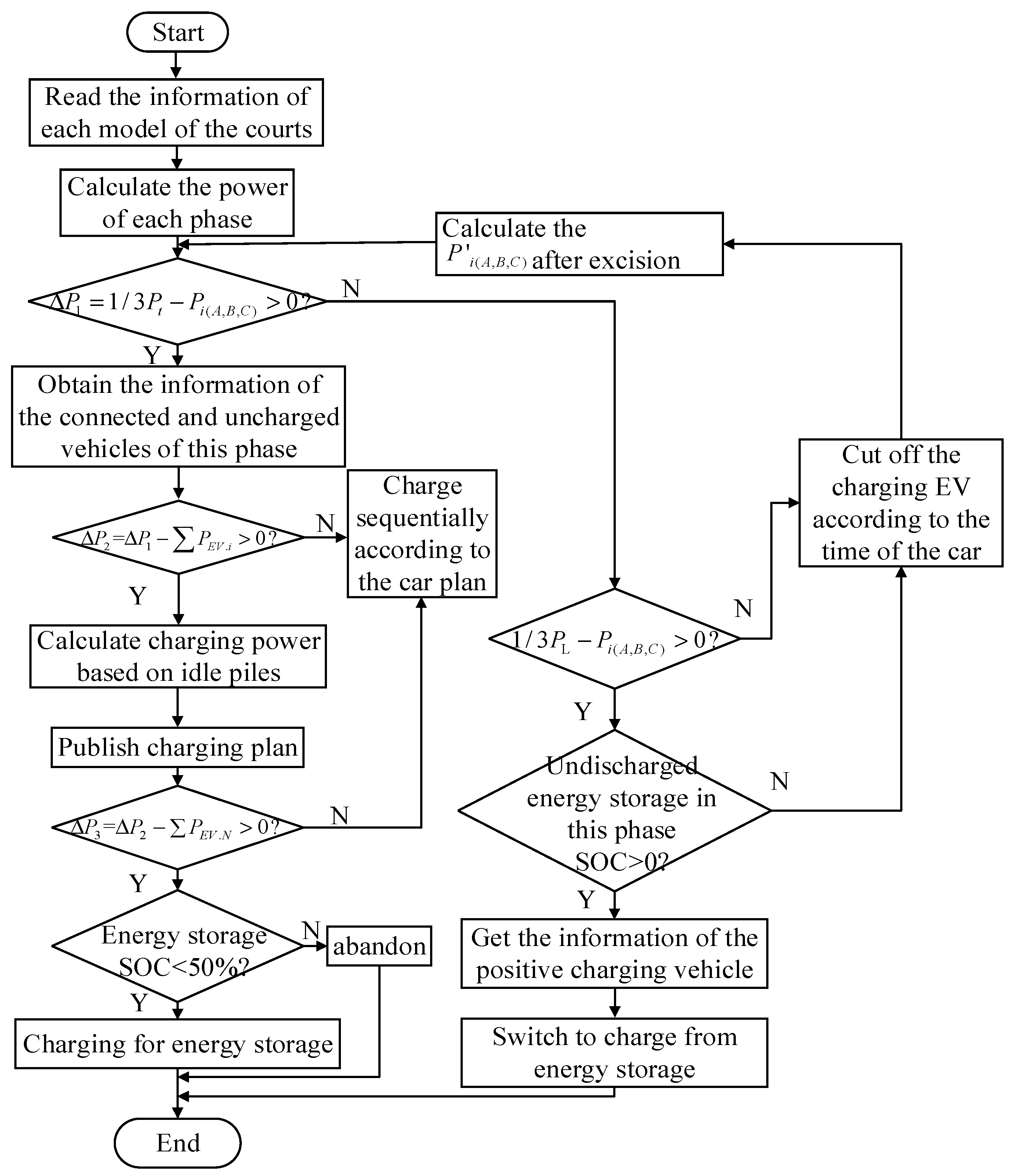
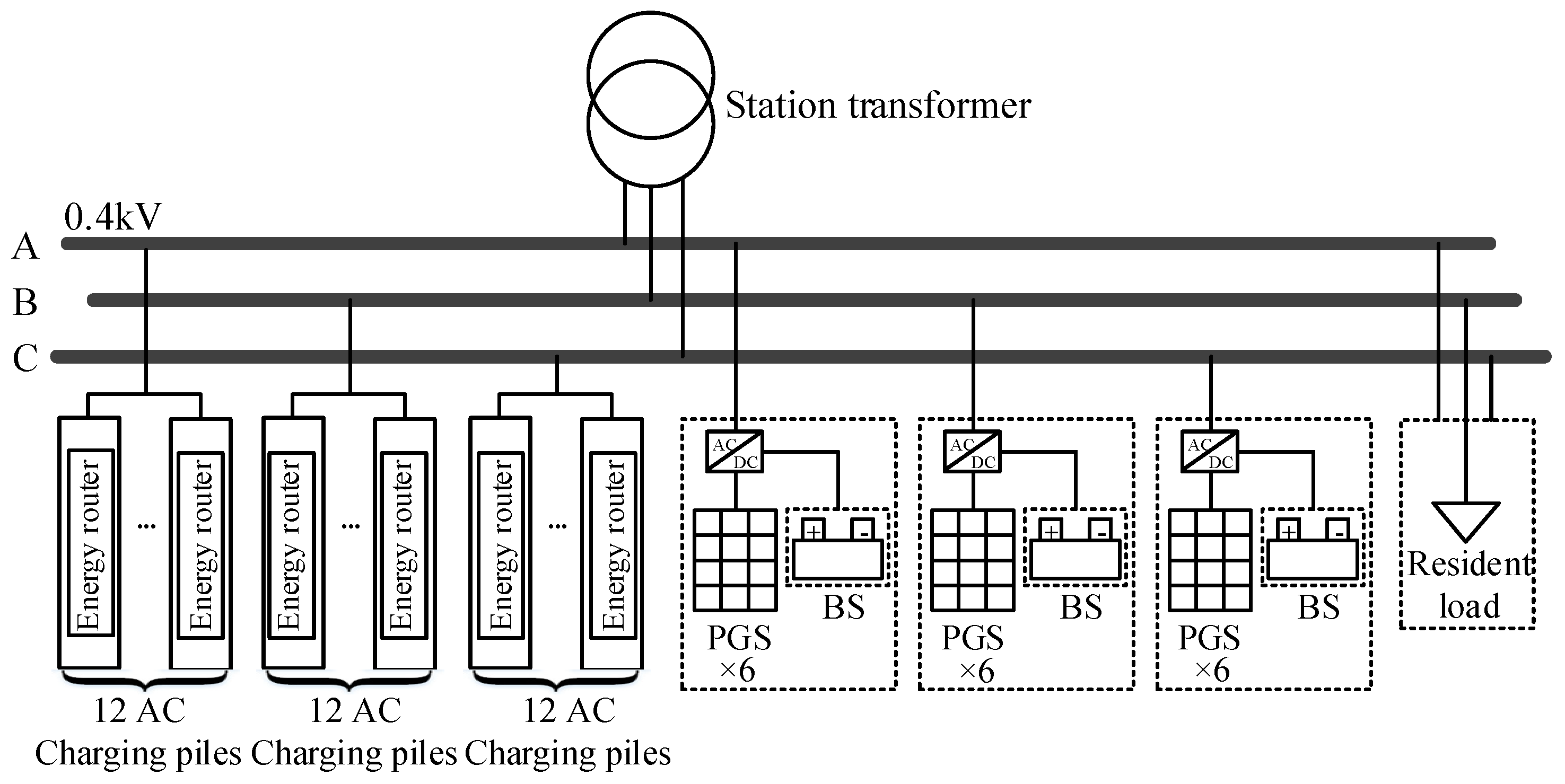
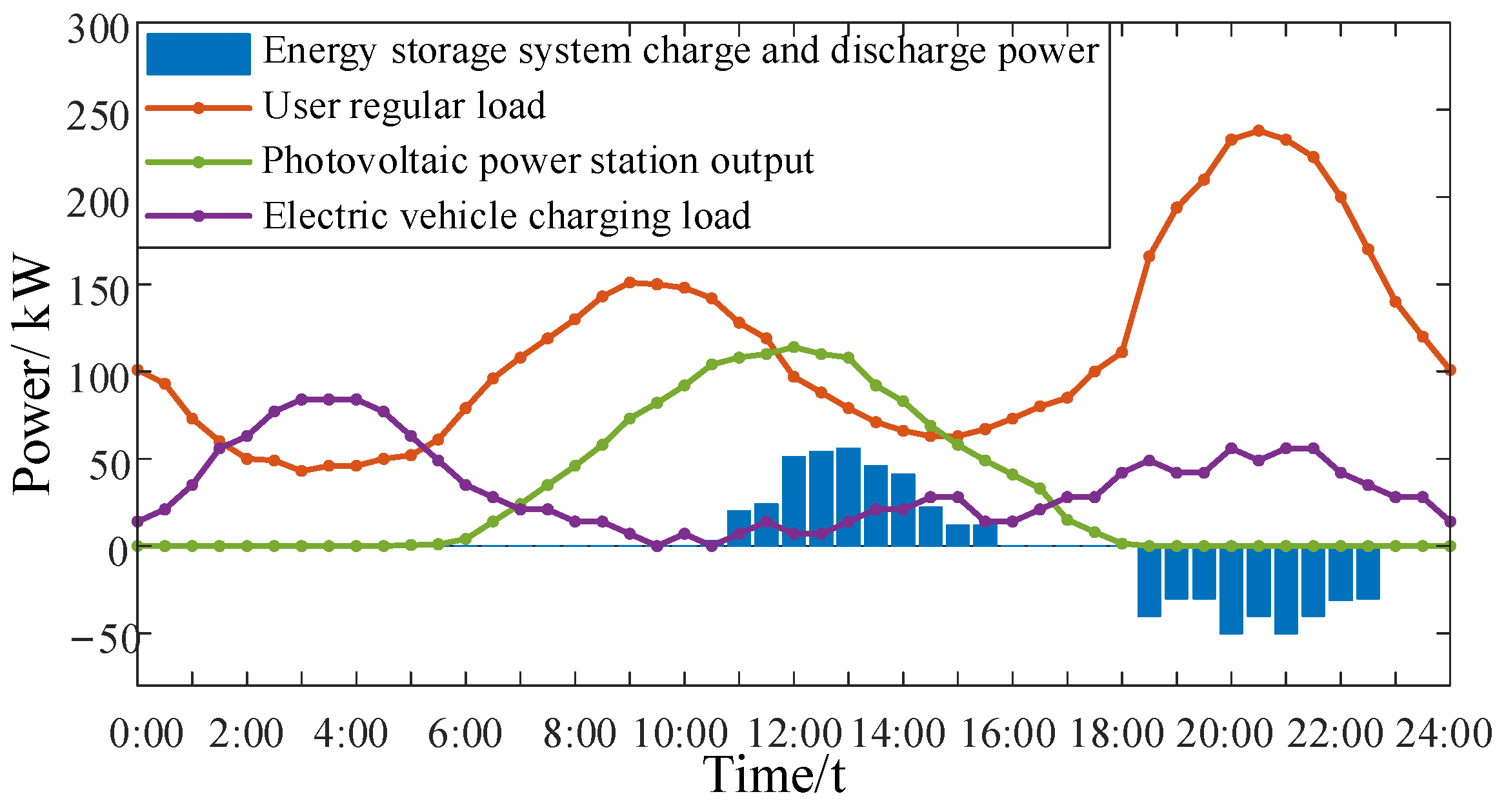
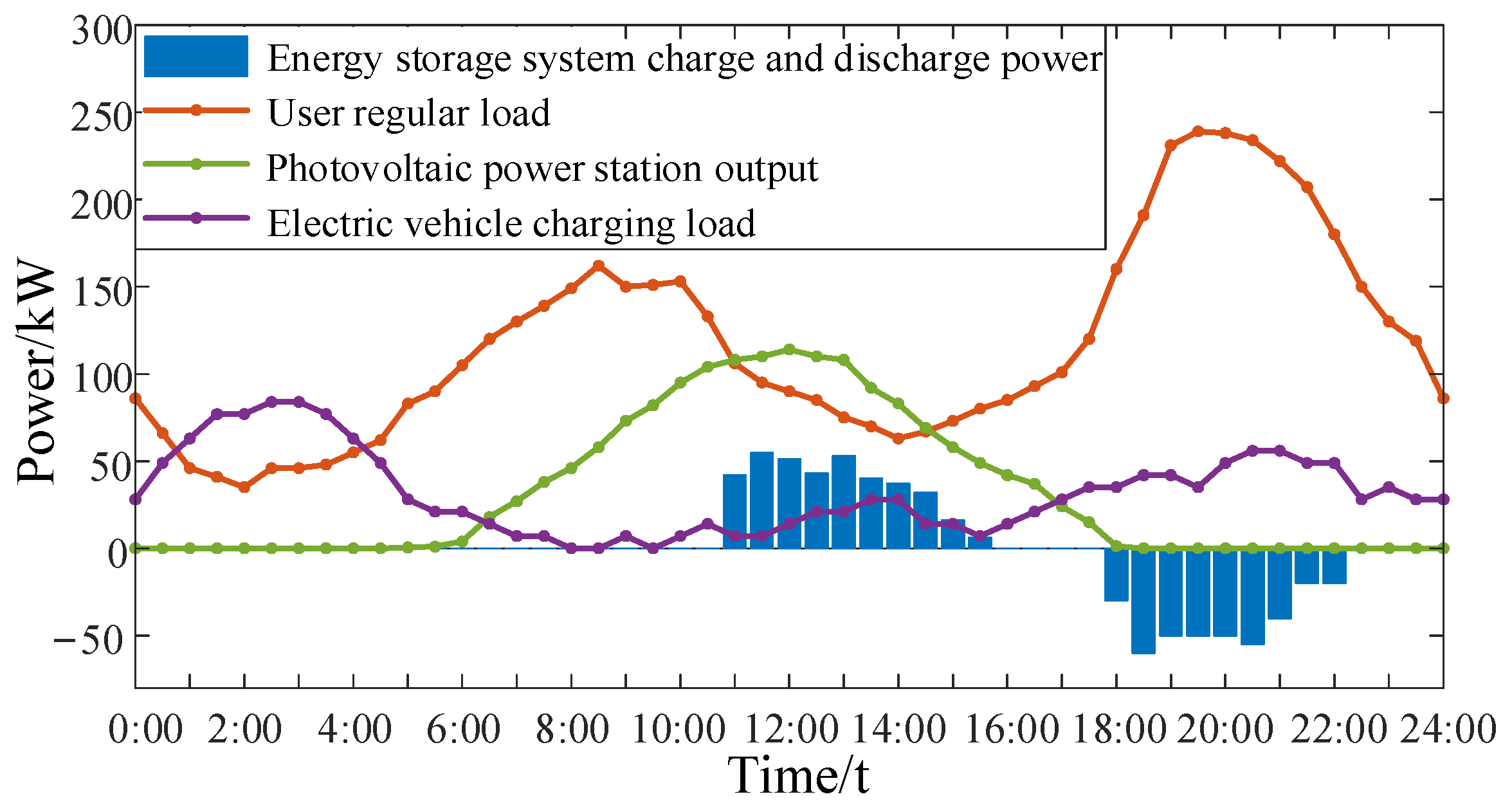
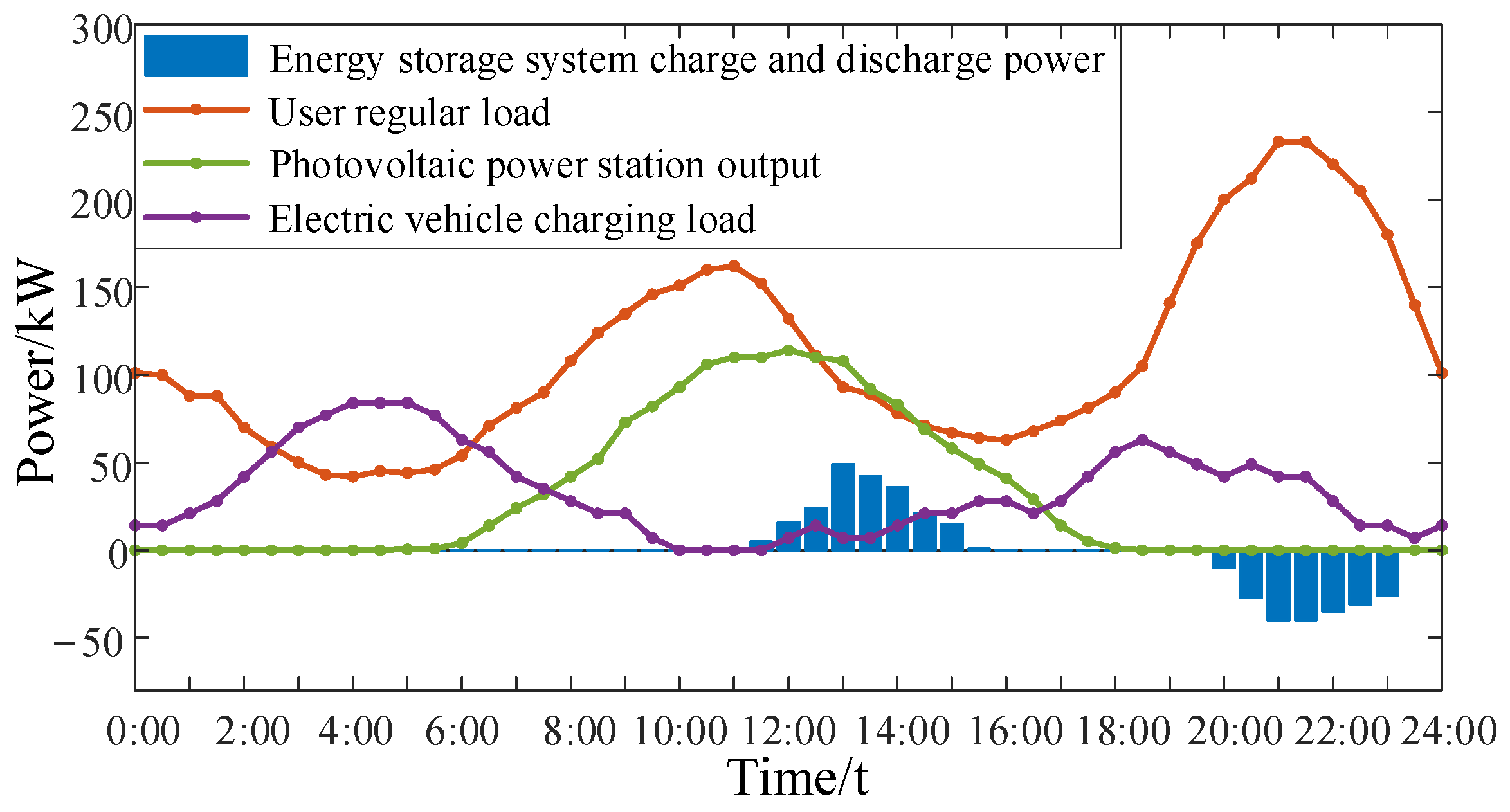

Publisher’s Note: MDPI stays neutral with regard to jurisdictional claims in published maps and institutional affiliations. |
© 2021 by the authors. Licensee MDPI, Basel, Switzerland. This article is an open access article distributed under the terms and conditions of the Creative Commons Attribution (CC BY) license (https://creativecommons.org/licenses/by/4.0/).
Share and Cite
Gao, H.; Yang, L.; Duan, H. The Local Ordered Charging Strategy of Electric Vehicles Based on Energy Routers under Three-Phase Balance of Residential Fields. Appl. Sci. 2022, 12, 63. https://doi.org/10.3390/app12010063
Gao H, Yang L, Duan H. The Local Ordered Charging Strategy of Electric Vehicles Based on Energy Routers under Three-Phase Balance of Residential Fields. Applied Sciences. 2022; 12(1):63. https://doi.org/10.3390/app12010063
Chicago/Turabian StyleGao, Hui, Lutong Yang, and Haowei Duan. 2022. "The Local Ordered Charging Strategy of Electric Vehicles Based on Energy Routers under Three-Phase Balance of Residential Fields" Applied Sciences 12, no. 1: 63. https://doi.org/10.3390/app12010063





